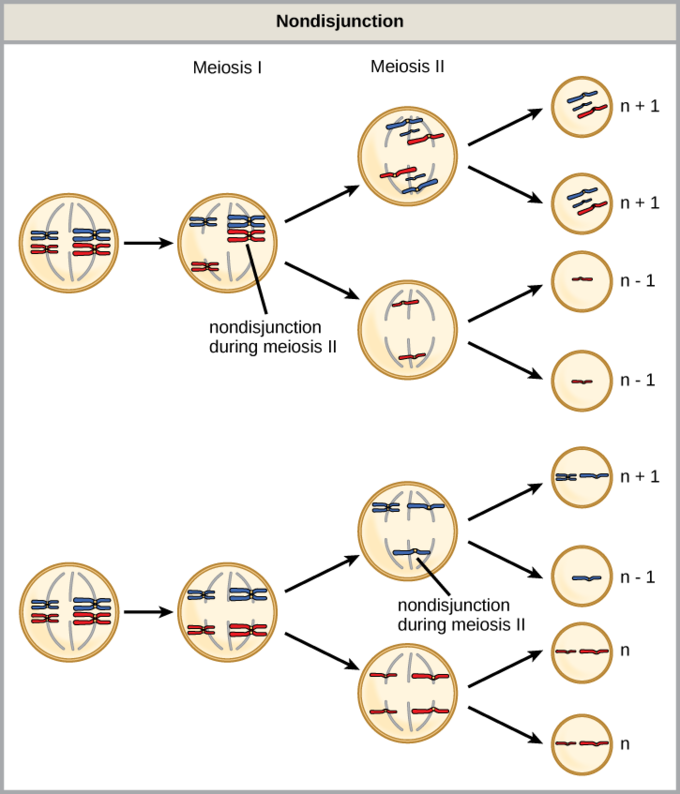13.2A: Disorders in Chromosome Number
- Page ID
- 13280
Aneuploidy, an abnormal number of chromosomes in a cell, is caused by nondisjunction, or the failure of chromosomes to separate at meiosis.
- Define aneuploidy and explain how this condition results from nondisjunction
Key Points
- Aneuploidy is caused by nondisjunction, which occurs when pairs of homologous chromosomes or sister chromatids fail to separate during meiosis.
- The loss of a single chromosome from a diploid genome is called monosomy (2n-1), while the gain of one chromosome is called trisomy (2n+1).
- If homologous chromosomes fail to separate during meiosis I, the result is no gametes with the normal number (one) of chromosomes.
- If sister chromatids fail to separate during meiosis II, the result is two normal gametes each with one copy of the chromosome, and two abnormal gametes in which one carries two copies and the other carries none.
- Aneuploidy can be lethal or result in serious developmental disorders such as Turner Syndrome (X monosomy) or Downs Syndrome (trisomy 21).
Key Terms
- aneuploidy: the state of possessing a chromosome number that is not an exact multiple of the haploid number
- nondisjunction: the failure of chromosome pairs to separate properly during meiosis
Disorders in Chromosome Number
Of all of the chromosomal disorders, abnormalities in chromosome number are the most obviously identifiable from a karyotype and are referred to as aneuploidy. Aneuploidy is a condition in which one or more chromosomes are present in extra copies or are deficient in number, but not a complete set. To be more specific, the loss of a single chromosome from a diploid genome is called monosomy (2n-1). The gain of one chromosome is called trisomy (2n+1).They are caused by nondisjunction, which occurs when pairs of homologous chromosomes or sister chromatids fail to separate during meiosis. Misaligned or incomplete synapsis, or a dysfunction of the spindle apparatus that facilitates chromosome migration, can cause nondisjunction. The risk of nondisjunction occurring increases with the age of the parents.
Nondisjunction can occur during either meiosis I or II, with differing results. If homologous chromosomes fail to separate during meiosis I, the result is two gametes that lack that particular chromosome and two gametes with two copies of the chromosome. If sister chromatids fail to separate during meiosis II, the result is one gamete that lacks that chromosome, two normal gametes with one copy of the chromosome, and one gamete with two copies of the chromosome. If a gamete with two copies of the chromosome combines with a normal gamete during fertilization, the result is trisomy; if a gamete with no copies of the chromosomes combines with a normal gamete during fertilization, the result is monosomy.

Aneuploidy often results in serious problems such as Turner syndrome, a monosomy in which females may contain all or part of an X chromosome. Monosomy for autosomes is usually lethal in humans and other animals. Klinefelter syndrome is a trisomy genetic disorder in males caused by the presence of one or more X chromosomes. The effects of trisomy are similar to those of monosomy. Down syndrome is the only autosomal trisomy in humans that has a substantial number of survivors one year after birth. Trisomy in chromosome 21 is the cause of Down syndrome; it affects 1 infant in every 800 live births.


